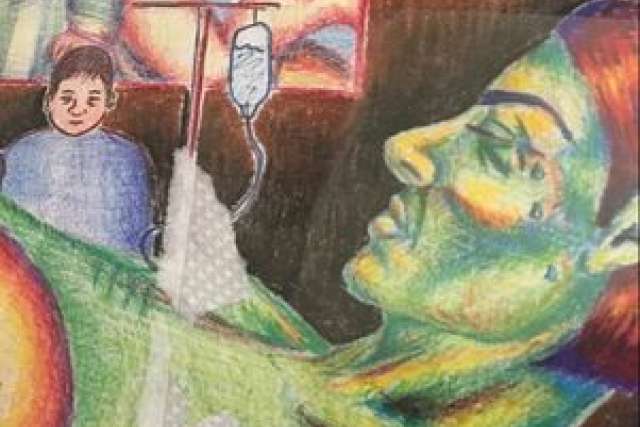The irony isn't lost on Woodland Hills resident Karen Kaufman. It was two bouts with two different cancers in less than a year that helped her return to her first true passion - art.
Her battle with sarcoma quickly followed by a lung cancer diagnosis altered her life path forever. A massage therapist, Kaufman is now focusing on creating her own unique, colorful three-dimensional collages.
Her works will be shown along side more than 35 pieces of art created by 16 cancer patients and survivors who took part in the Healing Through Art Group offered through UCLA's Jonsson Comprehensive Cancer Center. The special exhibit opens April 30, 2007.
The exhibit, "Beyond Words and Time: Women Fight Cancer Through Art" at the New Center for Psychoanalysis in West Los Angeles, is a collaboration with the Ted Mann Family Resource Center at UCLA, which offers the art therapy classes. The show includes the works of renowned Los Angeles artist Bonita Helmer, herself a cancer survivor.
"Creating art helps patients to process their feelings and develop coping strategies to assist them in their cancer journey," said Esther Dreifuss-Kattan, who holds doctorate degrees in art therapy and psychoanalysis and facilitates the Healing Through Art Group at UCLA. "Art making is a powerful tool for self-expression and self-awareness and a cultural phenomenon that raises awareness of physical vulnerabilities."
For Kaufman, that was definitely the case.
"I let go and let my feelings enter into my art," the 57-year-old said. "It was extremely cathartic and liberating and healing. It's a joy to be in that class."
Art therapy is just one of the mind-body classes offered by the Ted Mann center, which also provides a wide range of integrative oncology services and counseling. Anne Coscarelli, a psychologist and Ted Mann Center director, said art therapy helps participants to better process the losses associated with cancer and find healing and restoration.
"It's a way to make some sense from the cancer experience and to transform it, often providing new perspective on life," Coscarelli said. "Art allows them to express things that they may be unable or unwilling to express verbally."
An opening reception for the exhibit will be held from 3:30 to 6:30 p.m. on Saturday, May 5. Tara Branham, a Los Angeles actress and leukemia survival, will do a reading from "Other than That, I am Fine," her one-woman show about her experience fighting cancer. The art therapy "artists" exhibiting their work also will be on hand to answer questions about their work.
Alice Koga, a 50-year-old from Brentwood, was diagnosed with colon cancer in December 2005 and underwent surgery and six months of chemotherapy. A certified public accountant, Koga's art experience was limited to stick figures before she joined the art therapy class at UCLA.
"I had some apprehension. I thought I was supposed to create some kind of masterpiece or something," Koga said. "But in a way, it's kind of like being in the first grade again. You get to play with paints and tissue paper and clay."
Dreifuss-Kattan gently leads the group, often throwing out suggestions about what they might try to put into their pieces to express their feelings about a cancer diagnosis. She provides psychological support within the protected confines of the creative process.
"Through art, the patients are able to express their fears, anxieties, hopes and wishes related to their cancer experience and life in general," Dreifuss-Kattan said.
Koga said the art therapy classes allowed her to be "heard."
"One of the hardest things about going through the cancer journey is that people don't really hear you. They try to be helpful and concerned and supportive, but it really takes a person who has been through cancer to understand," Koga said. "I didn't have to pretend in the group. If I felt like crap, that was OK. I was able to let go of a lot of my defenses and just be."
Diane Fisher, 59, of Bel-Air, was diagnosed with endometrial cancer in November 2005 and underwent chemotherapy and radiation. She didn't know anyone with cancer and she didn't want to burden her partner of nine years with her intense fears and anxieties.
"I felt very alone. I didn't know anyone with cancer that I could talk to," Fisher said. "I felt art therapy would provide psychological support in a non-threatening environment. It did help me to cope, to talk about what I felt about having cancer. The anger came out and the fear of dying, in my words and in my art. It helped."
Culver City resident Hui Chang said the art therapy aided her tremendously. A 51-year-old mother of two, Chang was diagnosed in June 2006 with breast cancer that had spread to her lymph nodes. She found kindred souls in that room among the paint and tissue paper and clay.
"I love that group of women. We all have some difficulty to overcome, but we're all so full of energy in that room and not afraid to try new things," Chang said. "Cancer, in the end, made me appreciate life more. I rediscovered myself and it's wonderful."
All the "artists" in the show are excited about the exhibit and the chance to share their work with a wider audience. And their works, Dreifuss-Kattan said, are impressive. But for most of them, it was the creative process itself that worked the magic, allowing them to pour all their anger, fears and anxieties into the pictures, collages and sculptures.
"The art therapy classes became the highlight of my week," Koga said. "There are very few things that can distract you when you're going through chemo. Your mind is in a fog, you feel sick. Being in that environment felt like playing. I could just be creative. There was no pressure to talk if I didn't want to. There was just a really warm feeling in that room."



